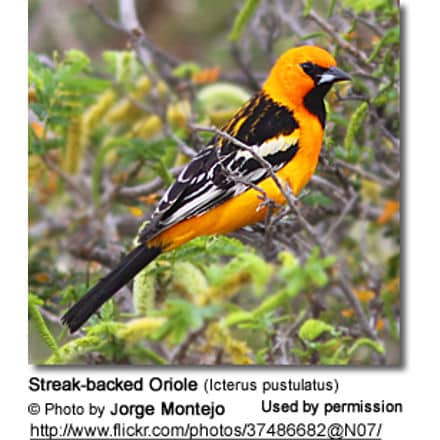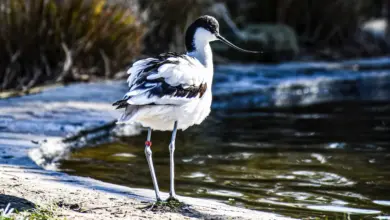Streak-backed Orioles
The Streak-backed Orioles (Icterus pustulatus) – also known as Flame-headed Orioles or Scarlet-headed Orioles – are primarily found along the west coast of Mexico and Central America, but are also occasional visitors in the Southwestern United States.


Distribution / Range
The Streak-backed Oriole
is a widespread oriole with a range that extends along most of the Pacific coast from northwestern Mexico in northeastern Sonora and western Chihuahua south into Sinaloa and through Central America. They are rarely observed in Guatemala, but have been recorded in El Salvador and into central Honduras and western Nicaragua.
On occasion, they breed in Arizona (southwestern United States) and vagrants have traveled further north.
They are most common at elevations of 1,650 – 6,560 feet (500 – 2,000 meters); favoring arid to semiarid areas of brushy woodland and scrub.
These orioles particularly seek out areas with thorny bushes, such as Mimosa in open woodlands, as well as areas of secondary growth and agriculture. In their northern range, they inhabitriparian areas in deserts.
Streak-backed orioles are found alone or in small groups. They may also associate with other orioles, frequently nesting near Spot-breasted Orioles or Altamira orioles.
Subspecies, Ranges and Identification / Description
According to the publication: “New World Blackbirds: The Icterids,” the subspecies are divided amongst three groups. What is unique to this group is that the males occurring in the northern range are brightly colored with dull-plumaged females.
As one moves southwards, the female plumages become gradually brighter until at the southern end of their distribution, the females look like the males.
Those more brightly colored females are also more active in territorial defenses than their duller northern counter parts.
Streak-backed Orioles measure about 7.87 inches (200 mm) in length (including the tail); the wingspan ranges from 3.54 – 4.65 inches (90 – 118 mm); and they weight between 2.47 – 3.00 oz (70 – 85 grams). Males are generally larger than females.
Scarlet-headed Oriole Group (northernmost group)
So named for the rich salmon to reddish feathers on the male’s head (which gave this group also the names of Flame-headed or Scarlet-headed Orioles). Males have a much brighter plumage than females.
The northern subspecies are partially migratory.
- Icterus pustulatus pustulatus (Wagler, 1829) – Nominate Form
- Range: South from Colima south to northern Oaxaca and east from Guanajuarto to Merelos, Puebla, and West VercuzID: Slightly larger in size than ssp. i.p. microstictus below.
- Icterus pustulatus microstictus Griscom, 1934
- Range: West Mexico from Sonora and western Chihuahua south to Jalisco. Some overwinter as far south as the state of Guerrero (southwestern Mexico).
The Tres Marías Oriole Group:
Plumage paler. Almost no streaking on backs. Females resemble males; except for having olive-colored tails.
- Icterus pustulatus graysonii Cassin, 1867
- Range: Restricted to the Tres Marías islands which lie along the western coast of Mexico (Nayarit)
Streak-backed Oriole Group (the southern group)
Larger in size; have entirely orange heads, and are almost completely monochromatic. Females can occasionally have some olive coloration.
- Icterus pustulatus alticola (W. deW. Miller and Griscom, 1925)
- Range: Occur in the dry areas of southern Guatemala and central western Honduras.ID: The back is the least streaked of all subspecies and is sometimes completely black.
- Icterus pustulatus maximus (Griscom, 1930)
- Range: Found in the arid Rio Negro valley in north central Guatemala.ID: Resemble ssp. I. p. aticola; but head is mostly yellow instead of orange.
- Icterus pustulatus sclateri (Cassin, 1867)
- Range: The most southerly population (may occasionally breed with Icterus pustulatus alticola) – occurs along the Pacific coast – from El Salvador south to northwestern Costa Rica. ID: Often larger than other subspecies. Head bright yellow. Back broadly streaked.
- Icterus pustulatus formosus (Lawrence, 1872)
- Range: Found in the extreme south of Mexico and northwestern Guatemala.ID: The head is a bright yellow-orange color.
- Icterus pustulatus pustuloides (van Rossem, 1927)
- Range: Endemic to the vicinity of Volcán San Miguel, in southern east central El Salvador.ID: Resemble ssp. I. p. alticola, except the head is reddish-orange in color.
Nesting / Breeding
Streak-backed orioles are seasonally monogamous (remaining with one mate for the entire breeding season).They usually breed once a year, with most nesting activities being reported in mid to late spring and ending in mid-to-late summer. Some variations between the different areas exist.
The female alone constructs the nest out of plant fivers in the shape of a long hanging basket (about 28 inches or 70 cm in length). These nests are attached to the tips of branches.
The average clutch consists of 3 – 4 eggs, which are incubated for 12 – 14 days to hatching. The young remain in the nest for about 2 weeks before fledging; and are being taken care of by both parents.
Immature birds reach reproductive age when they are about 1 year old. However, they have delayed plumage maturation, which means that even though they can breed in their first breeding season, they retain the juvenile plumages for some time afterwards.
Alternate (Global) Names
Chinese: ???? … Czech: trupiál žluví, Vlhovec žluví … Danish: Plettet Trupial … Dutch: Vlekrugtroepiaal … German: Piroltrupial, Pirol-Trupial … Finnish: Viiruselkäturpiaali … French: Oriole à dos rayé, Oriole à dos strié, Oriole à tête rouge … Italian: Oriolo dorsostriato … Japanese: zuakamukudorimodoki … Norwegian: Flammetrupial … Polish: Kacyk kreskogrzbiety, kacyk pasowoglowy, kacyk p?sowog?owy … Russian: ?????????????? ??????? ??????? … Slovak: trupiál škvrnitochrbtý … Spanish: Bolsero de fuego, Bolsero Dorsilistado, Bolsero Dorsirratado, Bolsero Dorsirrayado, Bolsero Dorso Rayado, Chichiltote Dorsilistado, Chorcha lomirayada, Turpial de Fuego, Turpial Dorsilistado … Swedish: Streckryggad trupial




